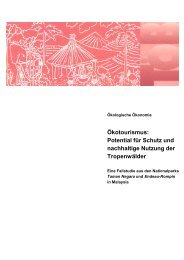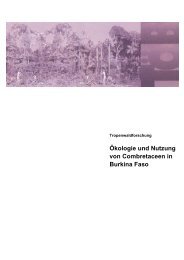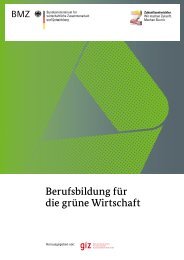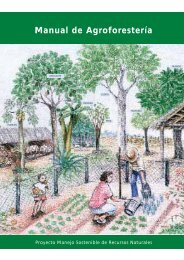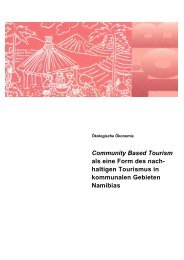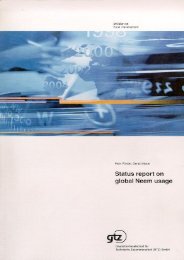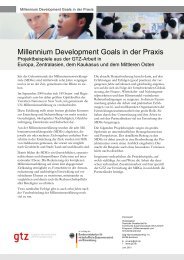Grand Housing Development Program Volume III - Gtz
Grand Housing Development Program Volume III - Gtz
Grand Housing Development Program Volume III - Gtz
Create successful ePaper yourself
Turn your PDF publications into a flip-book with our unique Google optimized e-Paper software.
BASICS ON ECOLOGICAL SANITATION- Operation of decentralizedsystem is key issue.- Decentralized systems reducethe import of fertilizer - reuseoptions by source separation(fertilizer, soil conditioner,biogas).DefinitionsThe term wastewater is used inthis report as the total flow of humanfaeces, urine as well as kitchenwastewater and wastewatergenerated through bathing andshowering. The latter ones aresummarised in the term greywater,whereas faeces are termedbrownwater and urine yellowwater.Faeces and urine together arecalled blackwater. For an overviewof the volumes of the differentstreams as well as their respectivecontent of organic matter and nutrientsplease refer to the followingfigure on this page.Stormwater is not included in thisinvestigation and should be conveyedand treated in a separatedsystem. Storage and use of rainwateras additional water supplyshould be considered.Production of waste waterper person per annum- Grew water: 25.000 - 100.000kg (low nutrient)- Yellow water (urine): 500 kg(high nutrient)- Brown water (faeces): 50 kg(high nutrient)Dry toilettes - Why?- Resource efficient sanitationmust consider relation to water<strong>Volume</strong>l/(P*year)Yearly Loadskg/(P*year)Greywater25.000 -100.000Flushwatercan be saved6.000 - 25.000Urine~ 500(CONTINUED)Feaces~ 50(option: addbiowaste)N ~ 4-5 ~ 3 % ~ 87 % ~ 10 %P ~ 0,75 ~ 10 %~50 % ~ 40 %K ~ 1,8 ~ 34 %~ 54 % ~ 12 %COD ~ 30 ~ 41 % ~ 12 % ~ 47 %S, Ca, Mg and trace TreatmentTreatment Biogas-PlantelementsCompostingReuse / Water Cycle Fertiliser Soil-ConditionerGeigy, Wiss. Tabellen, Basel 1981, Vol. 1, LARSEN and GUJER 1996, FITSCHEN and HAHN 1998Wastewater volumes and nutrient loadssupply.- Flushing toilettes waste highlyvaluable drinking water.- Black water cannot be reused.- Dry toilettes separate urineand faeces.- Dry toilettes allow reuse ofurine and faeces as nutrientsin agriculture.- Nutrients (urine & faeces) donot require additional treatment.- Urine is a high value fertilizer.- Faeces have to dry and canthen be used as soil conditioner(composted excreta).- Fertilizer contains phosphate.- The deposits of phosphate arebecoming exhausted.- To recover phosphate onerequires sulfate.- Sulphate deposits are becomingexhausted.- Prices for phosphate, sulphateand fertilizer are rising.Experiences with drytoilettesExperiences in rural areas areavailable in example from Kenya,Uganda and India as the link toagriculture in rural areas is directand obvious. Also first experiencesof dry toilets in mass housing constructionhas been made in DongSheng (Inner Mongolia) / China.Designs for dry toilettes for apartmentsare ready to be implementedas well as pilot projects as bestpractices. Awareness creationcampaigns are required.ECOLOGICAL SANITARY SYSTEMS BASICS ON ECOLOGICAL SANITATIONARGE Otterwasser GmbHTUTech Innovation GmbH31Addis AbabaCity Government



